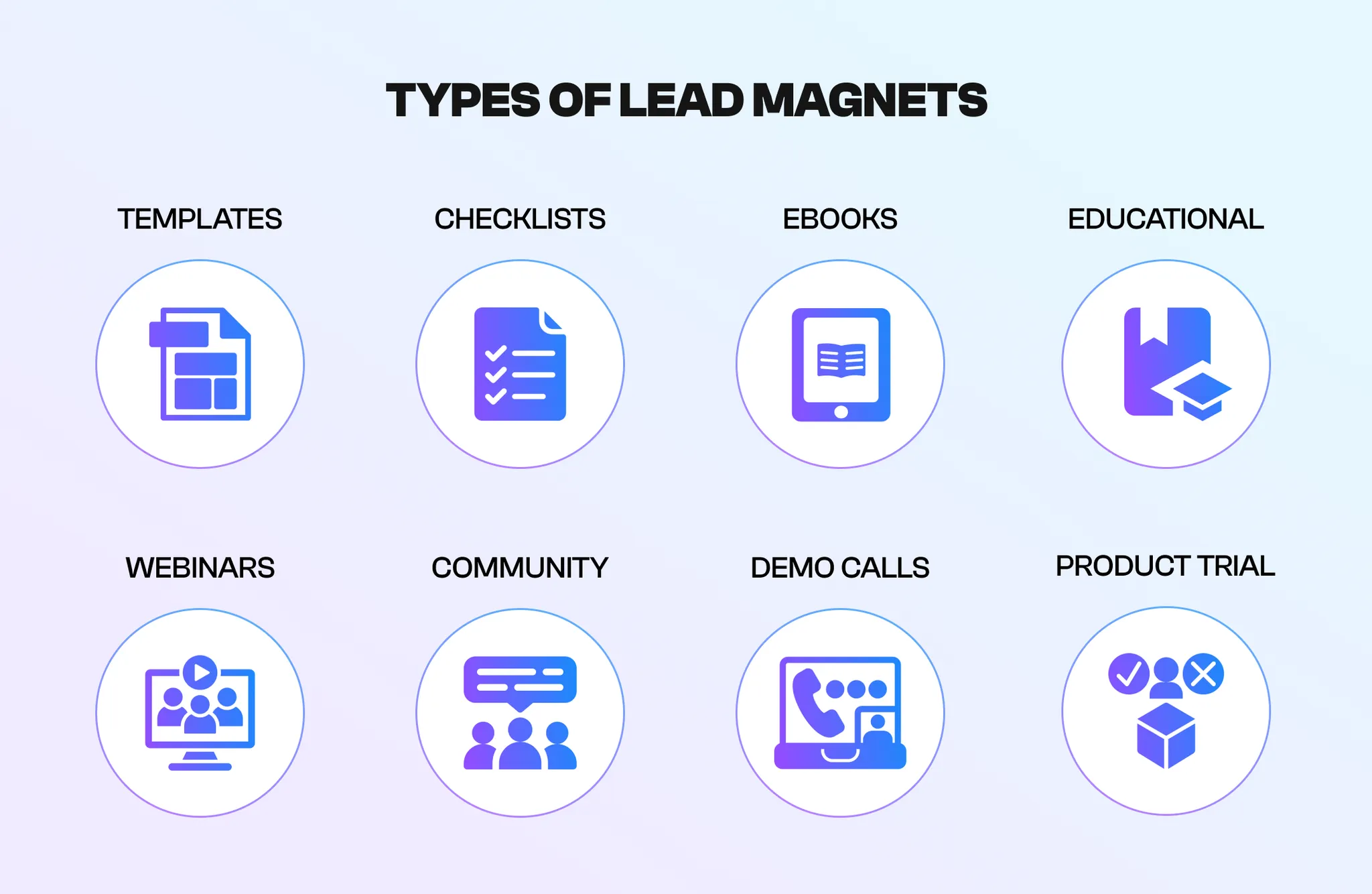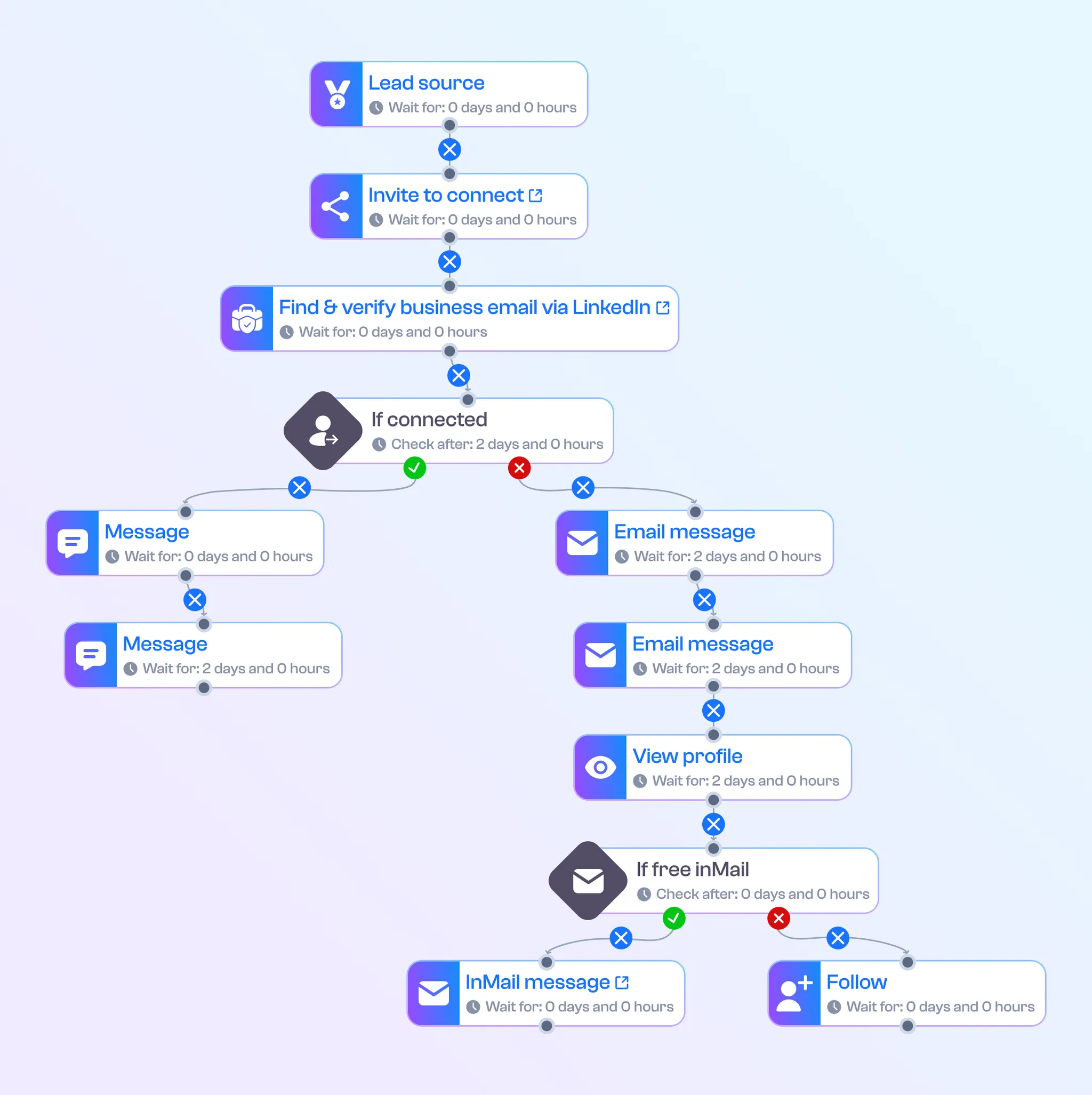What is lead generation strategy? It’s a structured approach to attracting, engaging, and converting potential customers into qualified leads to drive business growth.
Sounds simple, right? In reality, many businesses struggle because they rely on scattered tactics, hoping that a few cold emails or social media ads will magically bring in clients. Without the right approach, results are inconsistent, and growth stalls.
A structured approach ensures consistency, scalability, and, most importantly, results. According to HubSpot, 61% of marketers say generating traffic and leads is their biggest challenge. Yet, businesses with a well-defined strategy generate 133% more revenue than those without one. An effective B2B lead generation strategy keeps the pipeline full and revenue growing.
So, what is the best strategy for lead generation today?
- What Is a Lead Generation Strategy?
- Why B2B Lead Generation Matters
- Outbound vs. Inbound: Which One Works Best?
- Who Needs a B2B Sales Strategy?
- Inbound Lead Generation Strategies
- Outbound Lead Generation Strategies
- Breaking the Myths
- SalesAR Approach to Lead Generation
- Science Behind Outbound Lead Generation
- Measuring and Optimizing Your Strategy
- The Future of Lead Generation
- Conclusion
What Is a Lead Generation Strategy?
Lead generation attracts, engages, and converts potential customers into qualified leads. It’s what keeps the sales pipeline full and revenue flowing. Without a structured B2B lead generation strategy, businesses rely on random opportunities instead of predictable growth.

Why B2B Lead Generation Matters
A strong lead generation strategy brings in more leads and better leads. Companies with a strategic lead generation strategy get more revenue. Targeted outreach ensures sales teams focus on interested prospects rather than wasting time on the wrong audience.
Outbound vs. Inbound: Which One Works Best?
Both outbound and inbound marketing generate leads, but they serve different purposes.
- Cold emails, LinkedIn outreach, and calls
- You control the outreach and timing
- Faster results—ideal for filling pipelines quickly
- SEO, content marketing, and lead magnets
- Leads come to you—but it takes time
- Builds long-term trust and credibility
An outbound lead generation strategy is the best way to achieve immediate and predictable results in B2B sales. It puts your business in front of decision-makers rather than waiting for them to find you. A strong B2B sales strategy helps businesses target the right decision-makers and close deals more efficiently.

Who Needs a B2B Sales Strategy?
Any company that sells products or services to other businesses needs a structured B2B sales strategy. Unlike B2C sales, where purchases are often quick and emotional, B2B sales involve longer decision cycles, multiple stakeholders, and higher deal values. Without a clear B2B lead generation strategy, businesses risk inconsistent revenue, wasted resources, and missed opportunities.
- SaaS & Tech Companies – Selling software solutions to enterprises, startups, or mid-sized businesses.
- Marketing & Advertising Agencies – Target businesses needing B2B lead generation, branding, or digital marketing services.
- Manufacturing & Wholesale – Selling bulk products or equipment to other businesses.
- Consulting & Professional Services – Offering finance, HR, legal, or business strategy expertise.
- Cybersecurity & IT Services – Providing enterprises with infrastructure, security, and support.
- Startups & Scaleups – Need structured outbound and inbound efforts to acquire their first customers and scale revenue.
- Sales Teams & SDRs – Require a clear roadmap for prospecting, outreach, and closing deals efficiently.
- CEOs & Founders – Must ensure predictable revenue growth and market expansion.
- Marketing Teams – Align inbound efforts (content, SEO, paid ads) with outbound sales for maximum impact.
Inbound Lead Generation Strategies
Inbound strategy for lead generation focuses on organically attracting potential clients by providing valuable content and building brand credibility.
Unlike outbound, which delivers immediate results, inbound is a long-term strategy that compounds over time. Without a clear B2B sales strategy, companies risk losing potential clients to competitors with more structured outreach.
1. Content Marketing & SEO
Content marketing positions your company as an industry authority, while SEO ensures your content reaches the right audience. Over time, this builds trust and attracts high-intent prospects actively searching for solutions. Unlike cold outreach, inbound leads from SEO tend to have higher conversion rates because they discover your business on their terms.
- Focus on terms that signal buying intent, not just general industry topics.
- Use whitepapers, reports, and guides to capture contact information and move prospects into an outbound nurture sequence.
- Companies that publish high-quality content regularly see compounding traffic and B2B lead generation benefits.
- Supports credibility – When prospects receive a cold email, they often research your company. A strong content presence increases trust and response rates.
- Creates retargeting opportunities – Visitors from organic traffic can be nurtured further through outbound outreach, email sequences, and LinkedIn engagement.
- Fills the pipeline with warm leads – Prospects who engage with content are easier to convert when reached through outbound channels.
A strong content and SEO strategy isn’t just about visibility—it creates demand and ensures that when outbound efforts reach a prospect, they already recognize and trust your brand.

2. Lead Magnets & Gated Content
People are more likely to share their contact information if they receive something valuable in return. Lead magnets, such as downloadable guides, checklists, reports, or free tools, are powerful ways to capture high-intent prospects and move them into your outbound or nurture sequences.
Instead of waiting for prospects to book a call, gated content brings them into your pipeline early, giving your sales team more opportunities to engage and convert them.
- Provide something your audience truly needs.
- Keep forms simple (name, email, company), highlight the benefit of the content, and remove unnecessary distractions.
- Once a prospect downloads a resource, don’t just wait for them to engage further. Reach out with a personalized email referencing their interest.

- Warms up cold outreach – Instead of reaching out to completely cold prospects, your SDRs can target leads who have already shown interest in your industry.
- Provides conversation starters – Mentioning a resource they downloaded makes follow-ups more natural and relevant.
- Increases outbound conversion rates – Leads captured through gated content are more likely to respond positively when contacted, as they’ve already interacted with your brand.
A well-executed lead magnet B2B lead generation strategy generates a steady flow of engaged prospects, making outbound efforts more effective and conversations more productive.
3. Paid Advertising (Google Ads, LinkedIn Ads, Retargeting)
Paid advertising provides instant visibility and lets you capture demand. Unlike organic inbound strategies that take months to build momentum, Google Ads, LinkedIn Ads, and retargeting campaigns drive immediate traffic and leads.
Paid ads are especially powerful for B2B lead generation because they allow hyper-targeted outreach to decision-makers actively searching for solutions. Google Ads target prospects with high purchase intent, while LinkedIn Ads enable precise audience segmentation based on job title, industry, and company size.

- “Best [your solution] for [specific industry]“
- “Top-rated [service/product] providers”
- “How to solve [pain point]“
- Decision-makers in your ICP
- Companies showing buying intent (e.g., hiring for related roles)
- Visitors who engaged with your website or content
Implement retargeting campaigns – Use ads to re-engage website visitors who didn’t convert on the first visit.
- Warms up outbound prospects – Seeing your company in ads before receiving an email makes outreach feel more familiar.
- It creates a multi-touch experience. Prospects who engage with your ads can later be targeted via cold email or LinkedIn outreach.
- Supports outbound with data – Insights from ad performance (which messages and offers work best) can inform outbound email and call scripts.
A well-structured paid ad B2B lead generation strategy doesn’t replace outbound advertising—it amplifies it by generating brand awareness, retargeting engaged prospects, and capturing leads ready to convert.
Outbound Lead Generation Strategies
Outbound B2B lead generation puts businesses in control of their pipeline. Instead of waiting for leads, proactive outreach connects directly with decision-makers, accelerates sales cycles, and drives predictable revenue growth. When done strategically, outbound creates high-value conversations with prospects who might not have found your business otherwise.
1. Targeted Cold Email Outreach
Cold email remains the most effective and scalable outbound lead generation strategy. Unlike inbound methods that rely on organic discovery, cold outreach puts your message in front of key decision-makers, ensuring the right people see your offer.
Cold emails work when they’re highly targeted and personalized. Sending generic messages to mass lists leads to low response rates and wasted effort. But when emails are crafted with relevance and intent, they start real conversations and generate warm leads.
- Mention recent company news, shared connections, or specific challenges the prospect faces.
- Go beyond using a first name—tailor messaging to their role and industry.
- Experiment with different opening lines, personalization tactics, and call-to-action approaches to optimize results.
- Example: “Helping [Competitor Name] increase conversions by 30%—worth a chat?”
- Aim for 3-5 sentences.
- Highlight the problem, offer a solution, and simplify the next step (e.g., booking a quick call).

“Outbound isn’t about sending more emails—it’s about sending the right emails. A well-researched, personalized message to the right person is always more effective than blasting hundreds of generic emails. The goal is to create meaningful conversations, not just fill inboxes.” – Valeriya Krylova, Head of SDR
When executed correctly, cold email outreach is a high-impact, low-cost way to generate new business opportunities. Thus, it is a cornerstone of outbound B2B lead generation.
2. Cold Calling & Multi-Touch Outreach
Cold calling is one of the fastest ways to connect with decision-makers. While emails can be ignored and LinkedIn messages can sit unread, a direct phone call creates real-time engagement and allows reps to address objections instantly. A well-structured conversation can turn a cold prospect into a warm lead in minutes.
Cold calling works best as part of a multi-touch B2B lead generation strategy, where emails, LinkedIn messages, and calls increase response rates. Prospects who recognize your name from a previous touchpoint are far more likely to engage on a call.
- Prospects decide in the first 30 seconds whether they’ll stay on the call.
- Clearly state who you are, why you’re calling, and how you can help.
- Leaving a compelling voicemail increases the chances of a call-back.
- Follow up the voicemail with an email or LinkedIn message referencing the call.
“A well-executed call converts faster than any email. It allows you to handle objections in real-time, build rapport, and move deals forward immediately. The key is confidence, clarity, and knowing how to add value from the first second.”
Cold calling, combined with strategic follow-ups through email and LinkedIn, is one of the most effective outbound strategies. It’s not about dialing randomly—targeting the right people at the right time with the right message.
3. LinkedIn Social Selling
LinkedIn is the most powerful networking and B2B lead generation platform available today. Eighty percent of B2B leads come from LinkedIn, making it an essential channel for outbound sales.
LinkedIn allows for a more natural, relationship-driven approach, unlike cold email or calling. Decision-makers already use the platform to network, share insights, and explore solutions. The key to success? Warming up prospects before making a pitch.
- Sending a cold DM without context rarely works.
- Build familiarity by engaging with their posts, liking their content, and commenting thoughtfully.
- Before sending a connection request, interact with their recent posts.
- When you connect, personalize the message—mention mutual connections, shared interests, or industry challenges.
- Combine LinkedIn engagement with email and cold calls to increase recognition and response rates.
- Example: Like a prospect’s post → Send a connection request → Follow up with a personalized DM → Reinforce with an email.
“LinkedIn is where real B2B conversations start. DMs without context are ignored, but responses skyrocket when you engage first and show genuine interest. LinkedIn is a relationship-building tool, not just another sales channel.”
LinkedIn social selling isn’t about immediate sales—it’s about positioning yourself as a trusted industry expert. It creates higher engagement, stronger connections, and more meaningful sales conversations when done right.
Breaking the Myths
About Outbound Lead Generation
One of the biggest misconceptions is that cold outreach doesn’t work. It does—when done correctly. The problem isn’t outbound; it’s how most companies approach it.
- Mass-blasting generic emails? That doesn’t work.
- Personalized, well-researched messages? That gets replies.
When you reach out with a relevant message at the right time, you’re not interrupting but providing value. And that’s when real conversations (and deals) happen.
A few years ago, I sent a cold email that, by all logic, shouldn’t have worked. It was to the CEO of a mid-sized tech company—someone who likely received dozens of pitches daily. But instead of ignoring it, he replied within an hour. Three weeks later, we closed a six-figure deal.
Why? Because that email wasn’t just another generic pitch. It was researched, personalized, and timed perfectly. It spoke to his company’s problem, offered a clear solution, and made it easy for him to say yes to a conversation.
Outbound marketing, when done right, turns cold contacts into warm leads. It’s not about blasting thousands of messages and hoping for a response—it’s about reaching the right people with the right message at the right time.
Let’s break down what works and how to build a system that consistently wins more clients.
Learn how we build personalized outreach campaigns that convert — and let your team focus on closing.
SalesAR Approach to Lead Generation
Outbound sales isn’t about reaching out to as many people as possible—it’s about reaching the right people with the right message. At SalesAR, we take a strategic approach to outbound B2B lead generation, focusing on three key elements: targeting decision-makers, addressing real pain points, and personalizing outreach at scale.
ICP: Finding the Right Decision-Makers
Not all contacts are worth pursuing. Too many sales teams waste time on people who will never buy. That’s why defining an Ideal Customer Profile is the first step in any successful outbound B2B lead generation strategy.
- Industry & Company Size – Who benefits most from your solution?
- Job Title & Decision-Making Power – Are you reaching the person who can actually say yes?
- Budget & Readiness – Does the company have the budget and a need for your service now?
Companies that use a well-defined ICP generate 68% higher account win rates than those that don’t. Without one, you’re just guessing.
Understanding Pain Points
No one cares about your product—until they see how it solves their problem. The best outbound campaigns don’t just list features; they focus on specific pain points that keep prospects up at night.
- Industry trends – What challenges are companies in this space facing?
- Competitor weaknesses – Where are they falling short, and how can you improve?
- Job-specific struggles – What makes this prospect’s role difficult, and how can you make it easier?
For example, instead of saying, “Our software automates reporting,” say, “Most sales teams waste 5+ hours a week on manual reports. Our clients cut that time in half—would that be valuable for you?”
This shift from features to solutions makes all the difference.
Using Data to Improve Response Rates
Personalization isn’t just a buzzword—it’s the difference between getting ignored and booking a meeting. But how do you scale it without spending hours on each prospect?
- Intent Data – Tracking signals like job postings, funding rounds, or social media activity to reach prospects at the right time.
- Segmentation – Grouping leads based on industry, company size, or role to tailor messaging efficiently.
- Smart Automation – Using AI tools to personalize emails while keeping them human and authentic.
Personalized outreach generates 202% more responses than generic messaging. The key is making every prospect feel like the message was written just for them—without actually writing each one from scratch.
Science Behind Outbound Lead Generation
Every effective campaign starts with precise targeting backed by data and strategy. At SalesAR, we don’t just reach out to random companies; we focus on the most likely converting accounts. The difference? A targeted approach increases response rates because you get results when you speak to the right person with the right message.

Step 1: Research & Targeting
Most outbound campaigns fail before sending the first email because they lack a solid foundation. Research and targeting determine whether your outreach resonates or is ignored.
- Identifying High-Potential Accounts – We start with firmographics: industry, company size, location, and revenue. But that’s just the beginning. We go deeper, looking at hiring trends, funding rounds, and tech stack usage to find companies ready to buy.
- Leveraging LinkedIn for Precision Targeting – LinkedIn isn’t just a networking tool—it’s a goldmine for sales intelligence. We analyze decision-makers’ activity, recent job changes, and content engagement to pinpoint the best contacts within a company.
- Tracking Buying Signals: Timing is everything. Is a company expanding its sales team? Has it just raised funding? Is it posting about a problem your solution solves? These triggers indicate high intent, making outreach far more effective.
“The days of cold email spam are over. If you want results, every message must feel like it was written just for that prospect. A targeted approach increases response rates by 300%. It’s not about blasting emails—crafting the right message for the right person at the right time.”
Research-driven targeting turns outbound B2B lead generation into a predictable, repeatable process. When you know exactly who to reach and what matters to them, your outreach becomes impossible to ignore.
Step 2: Crafting Cold Emails That Get Replies
Your email is competing with hundreds of others in a crowded inbox. If it doesn’t grab attention immediately, it’s getting deleted—or worse, marked as spam. The problem? Most cold emails fail because they’re too generic, long, or vague.
- Using a Generic Template – Prospects can spot a copy-paste job from a mile away. If your email looks like everyone else’s, expect the same (low) response rate.
- Make It Specific – Mention their company, a recent achievement, or a challenge relevant to their role.
- Too Long & Complicated – It won’t be read if it takes effort.
- Keep It Short – 4-6 sentences max. Get to the point.
- Weak Call to Action (CTA) – Saying “Let me know if you’re interested” puts the work on them.
- Make It Easy to Say Yes – Example: “Do you have 10 minutes this Thursday to see if this works for you?”
The SalesAR Cold Email Formula
- Problem – Identify a pain point your prospect is facing.
- Solution – Show how your product/service fixes it.
- Social Proof – Briefly mention a client success story or relevant result.
- CTA – A simple, low-friction request for a quick call.
A/B Test on Cold Email Subject Lines
We ran an A/B test on two subject lines for the same email campaign targeting SaaS companies.
- Subject Line A: “Quick question about [Company Name]” = 18% open rate
- Subject Line B: “Reduce Costs by 25%: Action Plan for [Company Name]” = 32% open rate
The second subject line performed 78% better because it was specific, relevant, and hinted at value.
Small tweaks like this make a huge difference. A well-crafted cold email doesn’t just open; it gets replies, meetings, and deals closed.
Step 3: Follow-Ups – Where Most Deals Are Won
Most deals aren’t closed on the first email. That means nearly half of salespeople are walking away from potential deals before they’ve even started.
Following up isn’t about being annoying—it’s about staying on the prospect’s radar and providing value at the right moments. The key is persistence without becoming spammy.
How to Follow Up Without Being Ignored?
A weak follow-up sounds like this: “Just checking in to see if you got my last email.”
A strong follow-up adds value: “I came across a case study on how [Competitor Name] solved [specific problem]. I thought you might find it useful. I am happy to share insights if you are interested.”
Each touchpoint should feel like a natural continuation of the conversation, not a desperate attempt to get a reply.
The 5–7 Follow-Up Rule
The sweet spot is 5–7 follow-ups, spaced strategically. Each follow-up should add value—not just ‘checking in.’ If a prospect hasn’t responded, they’re either busy or unconvinced. Keep the conversation going by offering insights, sharing relevant content, or asking a new question that interests them.
The Ideal Follow-Up
- Day 1: Initial email
- Day 3: Follow-up with additional value (e.g., case study, article, or relevant news)
- Day 7: A short, direct message reinforcing the key benefit
- Day 14: A LinkedIn message or call to add a personal touch
- Day 21+: Final follow-up with a break-up email (“I don’t want to keep bothering you—let me know if this isn’t a priority right now.”)
Following up strategically increases response rates, keeps your pipeline moving, and ensures you’re not leaving deals on the table. The difference between a lost lead and a closed deal often comes from one more well-timed follow-up.
Discover what actually works — download our free PDF guide: “How to Generate Leads with Email”
Measuring and Optimizing Your Strategy
A great outbound B2B lead generation strategy isn’t just about sending emails and making calls—it’s about constantly refining your approach based on real data. The best sales teams don’t just guess what works; they measure, analyze, and optimize every step of the process.
What Metrics Matter?
- Response Rate – The percentage of prospects who reply to your outreach. (Good benchmark: 10–15%)
- Booked Meetings – How many replies turn into scheduled calls or demos? (Good benchmark: 3–5%)
- Conversion Rate – The percentage of booked meetings that turn into closed deals. (Good benchmark: 20–30%)
- Deal Size – The average revenue per closed deal, showing the overall impact of your outreach.
If these numbers aren’t where they should be, the next step is identifying why.
How to Increase Open Rates by 40%
At SalesAR, we ran an A/B test on email subject lines to see how small changes could impact open rates.
- Version A: “Quick question about [Company Name]” = 18% open rate
- Version B: “Reduce Costs by 25%: Action Plan for [Company Name]” = 32% open rate
- Version C: “[First Name], quick idea to improve [specific pain point]” = 40% open rate
By focusing on specific pain points and competitor comparisons, we boosted open rates by 40%. This simple tweak led to more conversations, booked meetings, and closed deals.
Common Pitfalls in Outbound Lead Generation
Poor Targeting = Wasted Efforts – If you’re reaching out to the wrong people, no amount of personalization will help. A well-defined ICP solves this problem.
Over-Automation = Generic Messaging – Too much automation leads to robotic, impersonal outreach. Prospects can tell when they’re just another name in a sequence.
Not Adapting to Feedback = Missed Opportunities – If prospects ignore a certain message, it’s time to change it. Sales teams that continuously refine their approach close more deals.
Measuring and optimizing strategy to generate leads isn’t a one-time task—it’s an ongoing process. The more data-driven your approach, the more consistent and scalable your B2B lead generation efforts will become. Refining your B2B sales strategy and improving conversion rates is essential.
The Future of Lead Generation
Outbound B2B lead generation is evolving faster than ever. What worked five years ago—mass email blasts, generic templates, and one-size-fits-all pitches—no longer delivers results. Buyers expect personalization, relevance, and meaningful engagement. The future belongs to sales teams that embrace technology while maintaining human and strategic outreach.
1. AI-Driven Personalization
Artificial intelligence is changing the strategy to generate leads. Instead of manually guessing which leads are most likely to convert, AI-powered tools analyze thousands of data points—job changes, funding rounds, hiring trends—to predict the best time and method for outreach.
- AI-driven personalization tailors messages based on prospect behavior, making cold outreach feel warm.
- Predictive analytics helps prioritize high-intent leads, allowing reps to focus on the best opportunities instead of wasting time on unqualified contacts.
2. Multi-Channel Outreach: The New Standard
Cold email alone is no longer enough. The best outbound strategies combine email, LinkedIn, and calls for a seamless, high-impact approach. An effective B2B sales strategy combines tactics like emails and calls with inbound efforts to nurture long-term relationships.
- Email – The first touchpoint is highly scalable when personalized.
- LinkedIn – Warms up prospects with engagement before direct outreach.
- Phone Calls – Builds trust and increases response rates for high-priority leads.
One thing remains constant: real connections drive real business. The more you focus on understanding and personalizing, the better your results will be. Technology can give you the tools, but building relationships is what truly closes deals. Companies that invest in a well-defined B2B sales strategy see higher revenue growth and more predictable sales pipelines.
Conclusion
Winning more clients isn’t about sending more emails—it’s about sending the right messages to the right people at the right time. A strong outbound B2B lead generation strategy is built on the following:
- Targeting the right decision-makers with a well-defined ICP.
- Crafting cold emails that stand out by focusing on personalization and value.
- Following up strategically to turn interest into booked meetings.
- Measuring and optimizing outreach using data-driven insights.
- Embracing AI and multi-channel engagement to stay ahead of the competition.
Want to build a winning B2B sales strategy? Let’s talk!
At SalesAR, we help businesses refine their outbound approach, improve response rates, and close more deals. If you’re ready to take your B2B lead generation to the next level, reach out—we’d love to help.
We handle appointment setting with qualified B2B leads — you stay focused on growing revenue.


